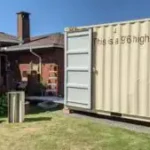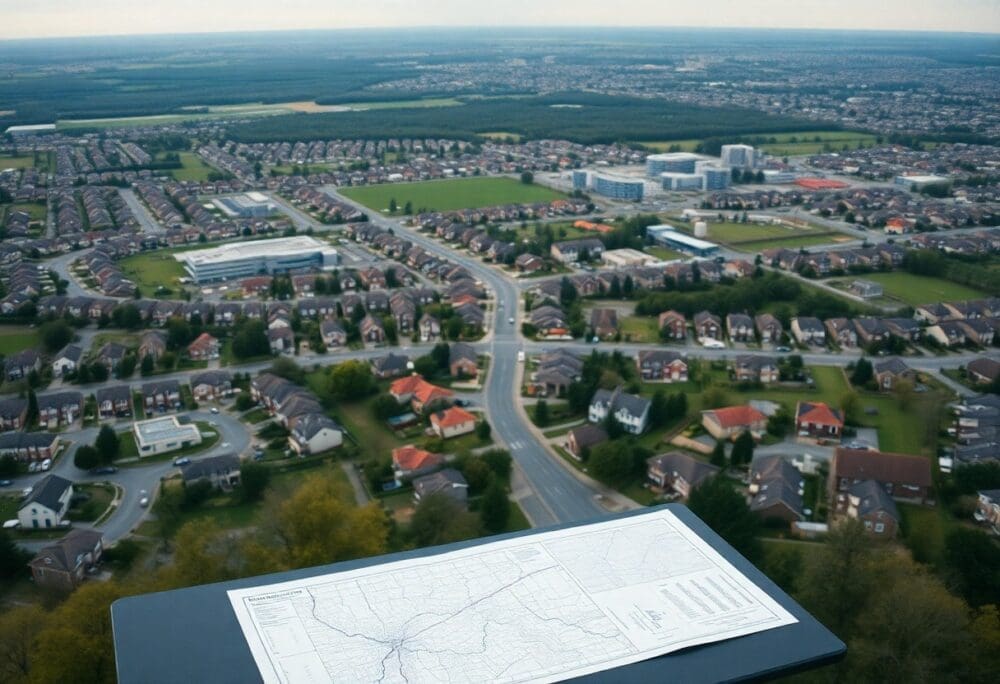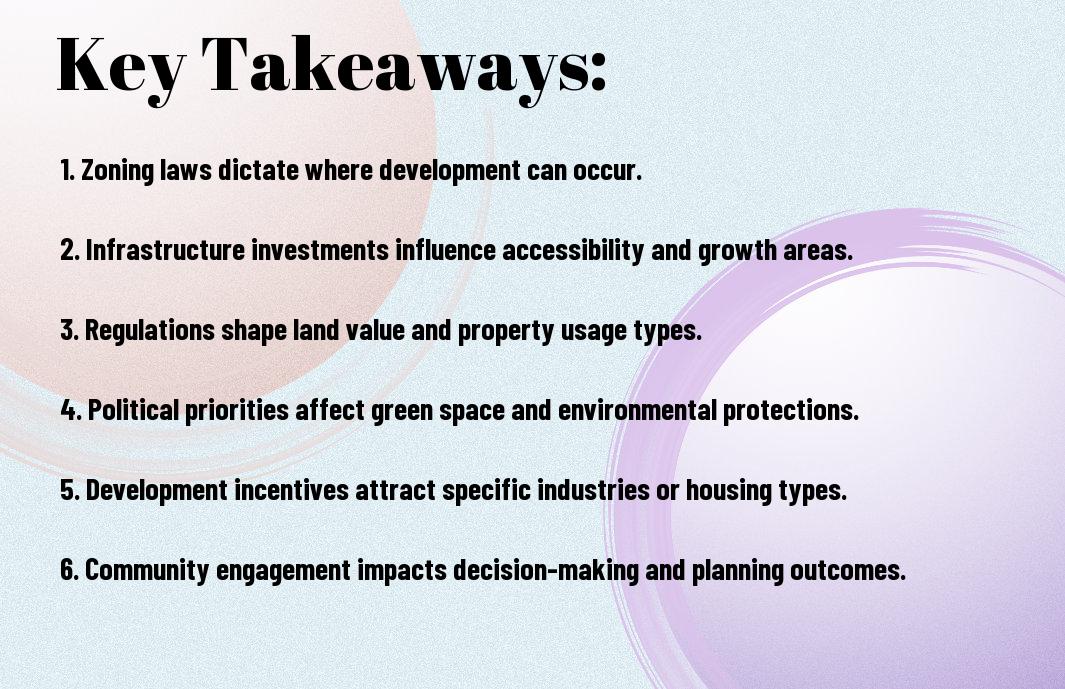Over time, political land use decisions have profoundly influenced the development and growth of suburban areas. As you navigate the complexities of urban planning and zoning regulations, it’s vital to understand how these decisions impact your community’s layout, infrastructure, and overall quality of life. Local governments play a significant role in shaping where homes, businesses, and parks can be established, which in turn affects traffic patterns, environmental sustainability, and social dynamics. In this blog post, you will explore the intricate relationship between political choices and suburban growth patterns, equipping you with insights to better engage in local planning discussions.
Key Takeaways:
- Political land use decisions significantly influence the distribution of resources and amenities, shaping where residential and commercial developments are located in suburban areas.
- Policy zoning regulations and infrastructure investments can either promote compact, sustainable growth or lead to sprawl, impacting environmental sustainability and community cohesion.
- Engagement in the political decision-making process by local communities can lead to more equitable land use outcomes that better reflect the needs and desires of residents.
Understanding Political Land Use Decisions
As a key factor in shaping suburban growth patterns, political land use decisions involve regulations and policies that determine how land can be utilized in various areas. These decisions are influenced by a multitude of factors, including economic considerations, community needs, and environmental impacts. Understanding the dynamics at play is crucial for grasping how these choices affect the built environment and ultimately guide the direction of suburban development.
Definitions and Key Concepts
About political land use decisions, you should recognize that they encompass zoning laws, allocation of resources, and planning strategies that directly influence land development. These concepts lay the groundwork for understanding how community layouts emerge and evolve, affecting residential, commercial, and industrial areas alike.
Stakeholders Involved in Land Use Decisions
Land use decisions are shaped by diverse stakeholders, including local government officials, property developers, community organizations, and residents. Each group presents their interests and influences the decision-making process according to their goals and values.
In addition to the primary stakeholders, various interest groups, such as environmental advocates and urban planners, play a role in the discourse surrounding land use. Their input adds depth to the conversation, ensuring that decisions consider environmental sustainability, economic viability, and demographic changes. By engaging with these stakeholders, you can better understand how their interactions shape the landscape of suburban development and influence your community’s future growth patterns.
Historical Context of Suburban Growth
It is necessary to understand that suburban growth has evolved significantly over the decades, shaped by various social, economic, and political factors. Initially, the post-World War II era saw a boom in suburban development spurred by the desire for family-friendly housing and expanded automobile access. These changes led to the establishment of new communities that offered a distinct lifestyle compared to urban centers, ultimately reshaping demographic and cultural dynamics in the United States.
Trends in Suburban Development
Historical trends in suburban development highlight patterns of migration, property investment, and infrastructural expansion. As cities became increasingly crowded and industrialized, many families sought the tranquility and space offered by suburban areas. You might notice a shift in residential preferences as more people gravitate toward single-family homes and community-oriented designs, reflecting a long-standing trend of suburbanization across the nation.
The Role of Government Policy
By analyzing the impacts of government policies on suburban growth, you can see how zoning laws, transportation funding, and housing incentives have played a significant role in shaping these areas. These policies not only dictate land use but also influence the types of developments that can thrive in suburban settings.
Suburban growth has been significantly influenced by government policies that encourage certain types of development over others. Policies such as tax incentives for homebuyers, the construction of highways, and zoning regulations that favor lower-density housing have all contributed to the expansion of suburban areas. You might find that these decisions often prioritize single-family homes while limiting alternatives like apartments, leading to a landscape that favors sprawl over sustainable development. Understanding these policies can help you gauge the future trajectory of suburban communities and their growth patterns.
Effects of Zoning Regulations
Now, it’s necessary to understand how zoning regulations significantly influence suburban growth patterns. These regulations dictate land use by designating specific areas for residential, commercial, or industrial purposes, ultimately shaping the character and layout of communities. By controlling the density and type of development, municipalities can both encourage and restrict growth, impacting everything from property values to quality of life.
Residential vs. Commercial Zoning
One of the primary distinctions in zoning regulations is between residential and commercial zoning. Residential zoning caters to housing developments, aiming to create safe, livable spaces for families, while commercial zoning allows businesses to thrive, fostering economic activity. The balance between the two can influence not only the availability of housing but also the amenities accessible to residents.
Impact on Community Structure
Between these zoning categories, you will find that the community structure is profoundly affected. Residential areas, often designed for tranquility and accessibility, can promote social interaction and cohesion through parks and communal spaces, while commercial zones attract traffic and economic opportunities. The interplay between these zones shapes your neighborhood’s dynamics.
At the core of this zoning interplay is how it fosters or hinders connectivity and accessibility in your community. If commercial zones are integrated within or nearby residential areas, you may experience enhanced convenience, encouraging walking or biking. Conversely, strict segregation can result in suburban sprawl, contributing to longer commutes and less communal interaction. Your quality of life, local economy, and community identity are all affected by these zoning decisions, making them pivotal in the overall growth pattern of suburbs.
Case Studies of Suburban Areas
After examining diverse suburban landscapes, you can recognize patterns shaped by political land use decisions. Notable case studies include:
- Reston, Virginia: A planned community that emphasizes mixed-use development, contributing to a 20% increase in local employment.
- Parker, Colorado: Implemented smart growth initiatives, resulting in a 30% decrease in traffic congestion.
- Frisco, Texas: Expanded public transit options, leading to a 15% rise in population density without sacrificing quality of life.
- Wilmington, Delaware: Adopted green building codes, achieving a 25% reduction in carbon emissions citywide.
Successful Land Use Policies
Suburban areas often thrive when effective land use policies are in place. These policies not only enhance economic viability but also improve resident satisfaction by creating accessible and vibrant communities. When you support mixed-use developments and prioritize public transportation, your suburbs can flourish and provide better opportunities for all residents.
Failed Planning Initiatives
Case studies of failed planning initiatives reveal the pitfalls of inadequate foresight and citizen engagement. These failures often lead to inefficient land use and exacerbate suburban sprawl, diminishing quality of life.
In fact, many suburban communities that neglect public input or fail to consider long-term growth impacts end up dealing with significant issues. For example, poorly planned residential zones may strain infrastructure, leading to traffic problems or inadequate services. You should be aware that such missteps can create lasting challenges, underscoring the importance of comprehensive planning and stakeholder involvement in suburban growth strategies.
Environmental Considerations
Despite the undeniable benefits of sound planning, land use decisions often overlook environmental implications. Policies that prioritize development over ecological preservation can lead to habitat destruction and increased pollution. Improving New York City’s Land Use Decision-Making … explores how integrating environmental considerations can create sustainable outcomes for surrounding communities.
Urban Sprawl vs. Sustainable Development
Environmental factors play a significant role in shaping the debate between urban sprawl and sustainable development. As cities expand, the unchecked spread often consumes valuable natural resources, worsening climate change effects. Shifting your focus towards sustainable development enables you to cultivate environmentally friendly practices that benefit your community and the planet.
Green Spaces and Public Health
Beside the aesthetic value, green spaces contribute significantly to public health and well-being. They provide vital areas for recreation, improve air quality, and promote mental wellness, making them vital components in urban planning.
Urban green spaces, such as parks and community gardens, serve as critical health resources. They not only provide recreational opportunities but also foster social interactions among residents. By integrating more green spaces into suburban development, you cultivate healthier environments that encourage physical activity and reduce stress levels, ultimately leading to improved public health outcomes.
Future Trends in Suburban Growth
Keep an eye on emerging trends that will significantly impact suburban growth. As urban areas expand, the intersection of technology, sustainability, and policy will shape not just how suburbs develop but also how they function. The rise of remote work, eco-friendly infrastructure, and improved public transportation will redefine what suburban living looks like, offering you new opportunities and challenges in your community.
Innovations in Land Use Planning
Land use planning is evolving with technology, enabling smarter, more sustainable urban designs. Innovative zoning laws and community engagement tools allow you to participate in shaping your neighborhood. These advancements ensure that suburban areas are more adaptable, integrating mixed-use developments that enhance your quality of life while addressing environmental concerns.
Predictions for Political Influence
An evolving political landscape is anticipated to reshape suburban growth patterns in the coming years. As local governments recognize the value of community engagement, your voice may carry more weight in land use decisions, leading to more responsive policies that consider your needs and aspirations.
With this potential shift towards greater citizen participation, you can expect political influence to become increasingly nuanced and reflective of local interests. Urban planners and policymakers are likely to focus on collaborative approaches, aligning growth strategies with community values. This means that as you engage in local discourse, your perspectives could directly impact land use policies, encouraging developments that prioritize sustainability and livability for future suburban growth.
Summing up
Hence, understanding how political land use decisions influence suburban growth patterns empowers you to recognize the intricate balance between policy, community planning, and environmental stewardship. As local governments set regulations and zoning laws, these choices shape the development landscape, affecting everything from accessibility to resource allocation. By engaging with these processes, you can advocate for sustainable practices that promote balanced and responsible growth in your own suburban environment.
FAQ
Q: What are some examples of political land use decisions that impact suburban growth?
A: Political land use decisions can include zoning laws, which dictate what types of structures can be built in specific areas, and comprehensive plans that outline long-term development goals for a region. For example, if a local government decides to zone a primarily agricultural area for residential development, it can lead to an increase in housing availability, which may attract new residents. Additionally, decisions about transportation infrastructure, such as expanding roads or public transit options, can shape suburban growth by making certain areas more accessible and appealing to potential residents.
Q: How do political land use decisions affect community amenities and services in suburban areas?
A: Land use decisions have a direct influence on the availability and distribution of community amenities, such as parks, schools, and shopping centers. If local authorities prioritize residential zoning over commercial or mixed-use development, suburban areas may face a shortage of vital services, leading to increased travel distances for residents. Conversely, if planners incorporate commercial zones alongside residential development, it can create a balanced community that offers residents easy access to services and fosters local economic growth.
Q: In what ways can public engagement influence political land use decisions in suburban areas?
A: Public engagement plays a vital role in shaping political land use decisions, as it allows community members to express their needs, concerns, and preferences regarding development. Through public hearings, surveys, or workshops, residents can provide feedback on proposed land use changes. This feedback can influence policymakers to modify plans to better align with the community’s interests. Additionally, active participation can lead to more transparent decision-making processes and encourage planners to consider the environmental, social, and economic impacts of development, ensuring that suburban growth meets the needs of all residents.






